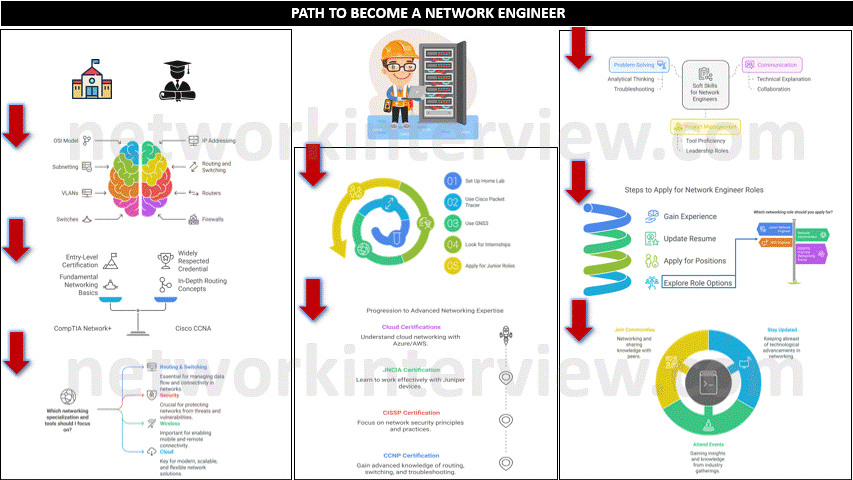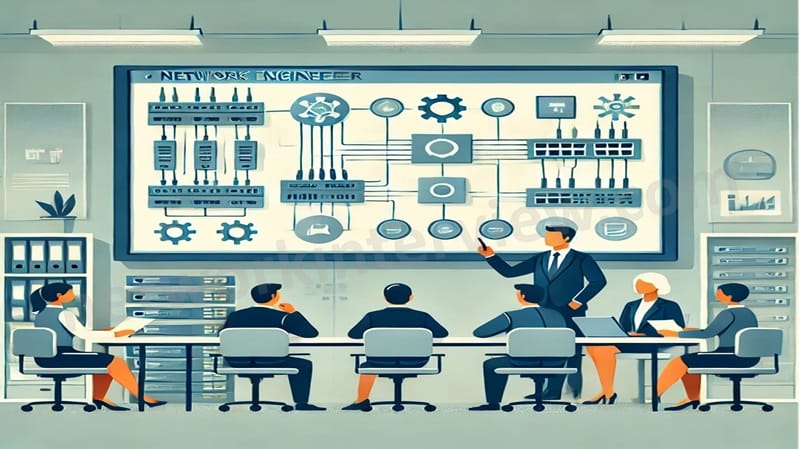Changing into a community engineer usually requires training, certifications, hands-on expertise, and steady studying.
A step-by-step path to changing into a community engineer
Here is a step-by-step information that will help you alongside the way in which:

1. Construct a robust academic basis
- Excessive Faculty: Concentrate on Arithmetic, Laptop Science and associated topics.
- Bachelor’s diploma (elective however useful): Pursue a level in pc science, info expertise, or community engineering. Some individuals begin with affiliate levels or technical certifications, however a proper diploma will be useful.
2. Be taught the fundamentals of networking.
- Research networking ideas such because the OSI mannequin, IP addressing (IPv4/IPv6), subnetting, routing and switching, and VLANs.
- Familiarize your self with community {hardware} corresponding to routers, switches, firewalls, and entry factors.
Associated: OSI Mannequin – 7 layers.
3. Get an entry-level IT certification.
Certifications reveal your data and enhance your employability. Begin with entry-level certifications corresponding to:
- CompTIA Community+: Covers the basics of networking.
- Cisco Licensed Community Affiliate (CCNA): Broadly revered and covers important networking ideas, routing, and switching.
4. Get hands-on expertise.
- House Lab: Arrange a lab with routers, switches, and digital machines utilizing instruments like Cisco Packet Tracer or GNS3 to observe configuration.
- Internship/Entry Stage Jobs: Search for internships or junior roles corresponding to IT help or community technician to achieve real-world expertise.
5. Grasp networking applied sciences.
- Be taught numerous areas of networking corresponding to routing and switching, safety, wi-fi, cloud, and automation.
- Achieve expertise with instruments and applied sciences corresponding to Wireshark, community analyzers, firewalls, and VPNs.
6. Intermediate and Superior Certification
As you progress, concentrate on extra superior certifications corresponding to:
- Cisco Licensed Community Skilled (CCNP): Extra superior data of routing, switching, and troubleshooting.
- Licensed Info Techniques Safety Skilled (CISSP): In case you are focused on community safety.
Juniper Networks Licensed Affiliate (JNCIA): To work on Juniper gadgets. - Microsoft Azure/AWS Certification: To know cloud networking.
7. Develop smooth expertise.
- Troubleshooting: Community engineers typically troubleshoot community issues, so sturdy analytical and problem-solving expertise are essential.
- Communication: You’ll need to elucidate and collaborate on technical ideas to non-technical colleagues.
- Challenge Administration: Expertise with challenge administration instruments may help you progress into management roles.
8. Discover community engineer roles.
After gaining expertise, begin making use of for community engineer positions. Maintain your resume updated and tailor it to spotlight your technical expertise and expertise.
Networking Roles You Can Discover:
- Junior Community Engineer
- Community Administrator
- Community Operation Heart (NOC) Engineer
- Techniques Engineer (Networking Focus)
9. Proceed to be taught
- Keep up to date: Networking applied sciences consistently evolve (eg, SDN, community automation, cloud networking, 5G), so steady studying is crucial.
- Attend webinars, conferences and workshops: Attend business occasions and on-line programs to remain forward of tendencies.
- Be part of networking communities: Interact in boards, on-line communities (corresponding to Reddit’s networking part) or skilled teams such because the Cisco Studying Community.
10. Promotion of senior roles
With expertise, purpose for extra senior roles, corresponding to:
- Senior Community Engineer
- Community Architect
- Community Guide
- IT Supervisor/Director
By following this step-by-step method, you will be properly in your option to changing into a profitable community engineer.
Ceaselessly Requested Questions for Community Engineer Interview

1. Are you able to clarify the distinction between TCP and UDP? (To evaluate your understanding of transport layer protocols and their use circumstances.)
2. How does subnet masks work in IP networking? (To check your data of IP Addressing and Subnetting)
3. Clarify the OSI mannequin and the way it applies to community troubleshooting. (To check your fundamental data of networking layers.)
4. What’s a VLAN, and why is it used? (To find out your understanding of segmentation and community design.)
5. Are you able to clarify how OSPF works and its advantages? (To evaluate your data of routing protocols.
6. Are you able to clarify the distinction between a change and a router? (A fundamental query to check understanding of community gadgets.)
7. How do you resolve community outages? (To evaluation troubleshooting approaches and instruments used for troubleshooting.)
8. How do you safe a community from frequent threats? (To discover data of firewalls, IDS/IPS, and community entry management.)
9. What do you do if two gadgets in numerous VLANs can’t talk? (Examines troubleshooting in VLAN and inter-VLAN routing.)
10. Describe a troublesome community downside you solved and the way you dealt with it. (To evaluate communication expertise, teamwork, and technical expertise.)







